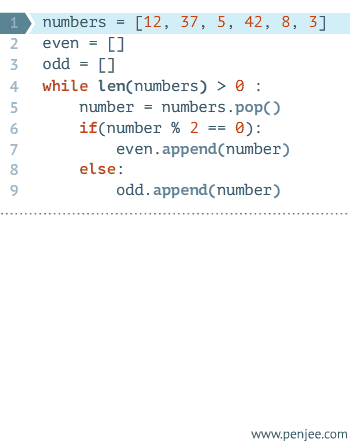python中的方法
if 条件语句
if 判断条件 :
xxxxxxx
else:
xxxxxxx
判断条件有多个时:
if 判断条件 :
xxxxxx
elseif 判断条件1 :
xxxxxx
elseif 判断条件2 :
xxxxxx
else:
xxxxxx
python 复合布尔表达式计算采用短路规则,即如果通过前面的部分已经计算出整个表达式的值,则后面的部分不再计算。如下面的代码将正常执行不会报除零错误:
a=0 b=1 if ( a > 0 ) and ( b / a > 2 ): print "yes" else : print "no"
循环:python中提供了for循环和while循环两种,
但是没有do ...while循环
控制语句有:break,continue,pass
while循环:1. while 判断条件 :
执行语句
2. while ....else 在循环条件为false时,执行else的部分。
while 语句时还有另外两个重要的命令 continue,break 来跳过循环,
continue 用于跳过该次循环,break 则是用于退出循环,此外"判断条件"还可以是个常值,表示循环必定成立
i = 1
while i < 10:
i += 1
if i%2 > 0: # 非双数时跳过输出
continue print i # 输出双数2、4、6、8、10
i = 1
while 1: # 循环条件为1必定成立
print i # 输出1~10
i += 1
if i > 10: # 当i大于10时跳出循环
break
无限循环:可以使用 CTRL+C 来中断循环。
while ....else
count = 0
while count < 5:
print count, " is less than 5"
count = count + 1
else:
print count, " is not less than 5"
for 循环: python中的for循环可以遍历任何序列的项目,比如一个列表或一个字符串
for letter in 'Python': #第一个实例
print '当前字母 :', letter
fruits = ['banana', 'apple', 'mango']
for fruit in fruits: #第二个实例
print '当前水果 :', fruit
fruits = ['banana', 'apple', 'mango']
for index in range(len(fruits)): #第三个实例
print '当前水果 :', fruits[index]
内置函数 len() 和 range(),函数 len() 返回列表的长度,即元素的个数。 range返回一个序列的数。
在for循环中的in :,for循环后的in跟随一个序列的话,循环每次使用的序列元素,而不是序列
的下标
s = 'qazxswedcvfr'
for i in range(0,len(s),2):
print s[i]
在for循环中的enumerate() :
在每次循环中,可以同时得到下标和元素
实际上,enumerate(),在每次循环中返回的是包含每个元素的定值表,两个元素分别赋值 index,char
for (index,char) in enumerate(s):
print "index=%s ,char=%s" % (index,char)
range()函数:
range(1,5) #代表从1到5(不包含5)
[1, 2, 3, 4]
range(1,5,2) #代表从1到5,间隔2(不包含5)
[1, 3]
range(5) #代表从0到5(不包含5)
[0, 1, 2, 3, 4]
continue语句:用在while和for循环中。continue语句跳出本次循环,break语句跳出整个循环。
continue语句用来告诉Python跳过当前循环的剩余语句,然后继续进行下一轮循环。
continue 语句是一个删除的效果,他的存在是为了删除满足循环条件下的某些不需要的成分。
n = 0
while n < 10:
n = n + 1
if n % 2 == 0: # 如果n是偶数,执行continue语句
continue # continue语句会直接继续下一轮循环,后续的print()语句不会执行
print(n)
pass占位符:pass是空语句,不做任何事情,只是为了保持程序结构的完整性。
当编写一个程序时,执行语句部分思路还没有完成,又不能空着不写内容,这时可以用pass来占位,过后再来编写代码。
比如: def iplaypython():
pass






